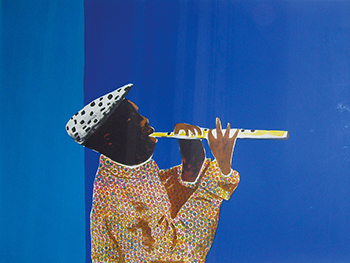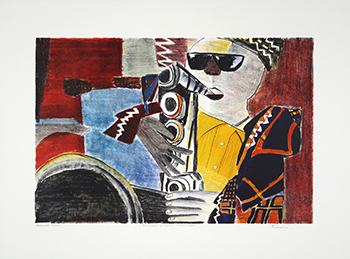Art in itself is a journey of self-exploration; with a global pandemic raging, art lovers can now explore this journey virtually. The Johannes Stegmann Gallery at the University of the Free State (UFS) is happy to announce the (second) virtual exhibition of Leeto: a Sam Nhlengethwa Print
Retrospective until 4 September 2020.

Sam Nhlengethwa, Tribute to Lemmy 'Special' Mabaso, 2002, Seven colour lithograph, 76 x 106 cm,
Artwork courtesy of the artist and the Goodman Gallery.
The exhibition features a collection of Sam Nhlengethwa’s print work to be interrogated, his artistic evolution to be mapped out, and his personal aesthetics to be interpreted, while surveying this renowned artist’s print work from 1978 to
2018. The underlying theme of the exhibition is jazz, an early influence in Nhlengethwa’s works from the underground jazz community of the townships. His brother was a jazz musician and he started collecting jazz records from the early
age of 17.
Leeto is a Setswana/Sesotho word for ‘journey’ and, as the word suggests, the exhibition explores the ongoing artistic footsteps of the artist. The collection was curated by Boitumelo Tlhoaele, a doctoral fellow in the Africa Open Institute
for Music, Research, and Innovation at Stellenbosch University.

Dedicated to Victor Ndlazilwana, 1994, Colour lithograph, 40 x 60 cm
Artwork courtesy of the artist and the Goodman Gallery.
About the artist:
Nhlengethwa began his career in 1976 during one of South Africa’s most tumultuous socio-political eras. In 1978, he completed a two-year diploma at the Evangelical Lutheran Church Art and Craft Centre, Rorke’s Drift, KwaZulu-Natal, where
printmaking was a prominent feature of the centre’s activities. Nhlengethwa’s work spans a variety of mediums, from painting, drawing to collage, and some of his works have been translated into tapestries. One of his big cityscape
works was translated into a mosaic. In addition to all the afore-mentioned mediums, Nhlengethwa also produced an impressive and sizeable body of printmaking works.
He has collaborated with several South African printmaking studios,
such as The Artists’ Press, Artist Proof Studio, David Krut Print Workshop, LL Editions Fine Art Lithography Studio, MK and Artist Print Workshop, Mo Editions Printmaking Studio, and Sguzu Printmaker’s Workshop. Since 1994, he has
produced 163 prints in collaboration with The Artists’ Press, making it his longest and most productive affiliation.